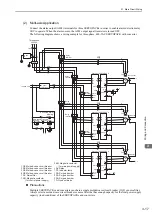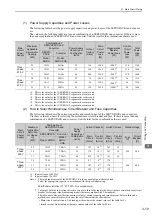
3.4 I/O Signal Allocations
3-29
3
Wi
ring an
d Conn
ecti
on
3.4
I/O Signal Allocations
This section describes the I/O signal allocations.
3.4.1
Input Signal Allocations
In most cases, input signals can be used at the factory settings. Input signals can also be allocated as required.
(1) Using Factory Settings
Items in cells with bold lines in the following table are the factory-set signal allocations.
If the control method is changed in Pn000.1, the signals will function as required for the control method.
The factory-set signal allocations will remain unchanged.
<Example>
When the control method is set to internal set speed control with a contact reference, i.e., when Pn000.1 is set
to 3, signal /P-CON (CN1-41) will function as /SPD-D, signal /P-CL (CN1-45) as /SPD-A, and signal /N-CL
(CN1-46) as /SPD-B.
Input signal allocation at factory setting can be checked using the parameters Pn50A, Pn50B, Pn50C, Pn50D,
and Pn515.
Pn000.1
Setting
Control Method Selection
CN1 Pin No.
40
41
42
43
44
45
46
0
Speed control
/S-ON
Uses as
/P-CON
P-OT N-OT
/ALM-
RST
/P-CL
/N-CL
1
Position control
2
Torque control
3
Internal set speed control
Uses as
/SPD-D
Uses as
/SPD-A
Uses as
/SPD-B
4
Internal set speed control
⇔
Speed control
5
Internal set speed control
⇔
Position control
6
Internal set speed control
⇔
Torque control
7
Position control
⇔
Speed control
Uses as
/C-SEL
Uses as
/P-CL
Uses as
/N-CL
8
Position control
⇔
Torque control
9
Torque control
⇔
Speed control
A
Speed control
⇔
Speed control with zero clamp function
Uses as
/ZCLAMP
B
Position control
⇔
Position control with reference pulse
inhibit function
Uses as
/INHIBIT
Pn50A
Uses input terminal with factory setting.
Allocates /S-ON signal to CN1-40.
Allocates /P-CON signal to CN1-41.
Allocates /P-OT signal to CN1-42.
Analog
Pn50B
Allocates N-OT signal to CN1-43.
Allocates /ALM-RST signal to CN1-44.
Allocates /P-CL signal to CN1-45.
Allocates /N-CL signal to CN1-46.
Analog
















































